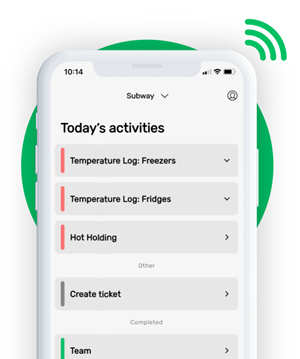FREE PRINTABLE FOOD ALLERGY WARNING SIGN | DOWNLOAD PDF
Use our free tool to create a food allergy warning label.
Just replace the words on the form when needed and download.


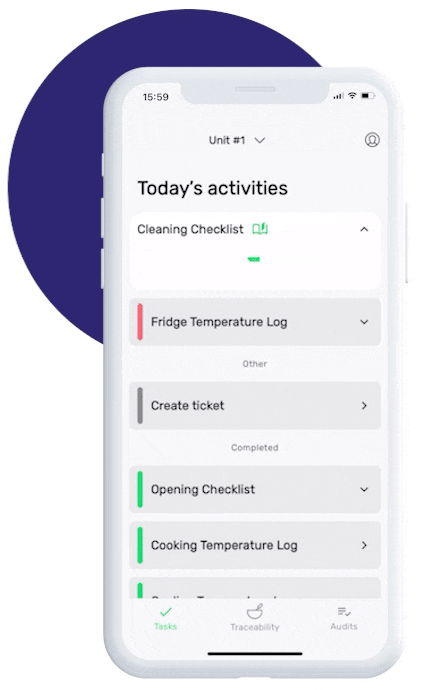
This is how our Digital Food Safety platform saves 20% of your time on daily tasks:
- Get upcoming task notifications
- Add data into the app
- Check the status of tasks in real-time

When food safety was still handled on paper, I typically spent a couple of hours per day getting the papers and going around checking or completing tasks… Now I can sit down and it's just all there in one place. It takes me 5-10 minutes.
Ruth B.
Store Manager
| FOOD ALLERGY WARNING |
|---|
| Please be advised that food prepared here may contain these ingredients: milk, eggs, wheat, soybean, peanuts, tree nuts, fish, and shellfish |
Customize and download your food allergy notice template
Although eating food is perhaps one of the most enjoyable things there is, there are just some foods that will not cooperate with our immune systems. Some individuals have hypersensitivity over particular food ingredients.
This medical condition can have mild symptoms to life-threatening severe reactions for some. That is why food business owners must always be wary of the foods they serve to their customers. A food allergy warning helps food businesses to inform their customers of the potential allergens contained in some of the dishes on your menu.
Key takeaways:
- Food allergies affect millions and can trigger severe reactions from eating certain foods.
- The Food Allergen Labeling and Consumer Protection Act of 2004 identifies eight major food allergens, and the FASTER Act adds sesame as the ninth from January 2023.
- Restaurants and food businesses are crucial in managing food allergens through proper labeling and customer communication despite different federal and state regulations.
- Food allergy warnings are beneficial not only for customer safety but also help protect businesses from legal and health risks.
- Symptoms of food allergies can range from mild itching to severe reactions like difficulty breathing and loss of consciousness.
- A food allergy notice helps inform customers about potential allergens, enhancing safety and compliance.
- Employees in food businesses play a key role in allergen management by informing and warning customers about potential allergens.
- Adverse reactions from food allergens can occur quickly, making early detection and response critical.
- Cross-contamination in kitchens is a significant risk for food allergen exposure, necessitating diligent allergen management practices.
- Digital Food Safety Management Systems (FSMS) by FoodDocs help businesses manage food safety efficiently and comply with regulations.
From 2018 to 2019, the Asthma and Allergy Foundation of America estimated that at least 32 million people suffer from food allergies in the US. Of these consumers, 26 million are adults whereas approximately 5.6 million are children. The Center for Diseases Control and Prevention predicted that one in three people with known food allergies contracts a triggered adverse reaction from restaurant dining.
Food allergies appear when our body's immune response system starts to react to a certain food or food product. That's why preventing them is crucially important in the food industry and for any food business.
Read more about what a food allergy warning is, who needs it, why we need it at all, and find the template above.
What are the major food allergens?
According to the Food Allergen Labeling and Consumer Protection Act of 2004 (FALCPA), eight foods are identified as major food allergens in the food supply:
- milk
- egg
- fish
- shellfish
- tree nuts
- peanuts
- wheat, and
- soybean
The most recent developments on the food allergy regulations of the U.S. Food and Drug Administration recently published the Food Allergy Safety, Treatment, Education, and Research (FASTER) Act. Under this law, sesame will also be recognized as the 9th major allergen starting January 1, 2023. It means that all food businesses need to inform their customers in any way about the food allergens their food may contain.
These eight major allergens in food are the cause of 90% of severe allergies and serious allergic reactions in the US. Milk allergy is most common for children with food allergies in the US, whereas tree nut food allergy accounts for the highest percentage among all US consumers with food hypersensitivities.
It means labeling on the menu, on the homepages, when entering the food business, when ordering food, when processing during food manufacturing - throughout the whole food supply.
How should food-allergic people act?
Food allergies can be serious, especially when triggered and left untreated. Individuals are responsible for knowing which food allergies they may have. Despite this, food businesses should inform customers of any potential food allergens that their food may contain.
This medical condition can only be triggered if an individual consumes, sometimes inhales, a triggering allergen that contains allergy-causing proteins. The immune system mistakes these particular compounds in the food as something harmful and reacts to it as defense which manifests as hypersensitivity reactions.
People with food allergies can experience a broad range of reactions and can manifest differently based on the food source and the affected individual. Medications are available to quickly address food allergy reactions and early detection is key with severe symptoms.
Here are some of the most common food allergy symptoms:
- Hives
- Skin reactions
- Tingling or itchy sensation in the mouth
- Face, tongue, or lip swelling
- Vomiting and/or diarrhea
- Abdominal pain
- Coughing or wheezing
- Dizziness and/or lightheadedness
- Swelling of the throat and vocal cords
- Difficulty breathing
- Loss of consciousness
These can escalate quickly into anaphylaxis, a life-threatening condition that requires immediate emergency action.
If a customer shows signs of an allergic reaction:
- Stop service immediately and remove the food.
- Call emergency services (911) and stay with the customer.
-
Ask if they carry an epinephrine auto-injector (like an EpiPen) and assist if they request help.
According to the CDC, early treatment improves outcomes. Every food business should have a clear allergy management plan and ensure all staff are trained to recognize these symptoms.
Allergic reaction is a serious health problem, don't underestimate it. If any of your customers experience any of these symptoms, it doesn't matter how common symptoms are, they should stop eating immediately and seek immediate medical attention.

How can food allergy warning signs help your restaurant?
While the Food Allergen Labeling and Consumer Protection Act of 2004 requires any food manufacturer dealing with pre-packaged foods to declare allergens in their food labeling or food packaging, this does not apply to restaurants. Using a food allergy warning sign has many benefits to any food establishment.
Here are a few advantages in using a food allergy warning sign:
- Assurance of food safety: While the main point of using an allergen warning is to inform consumers, it also helps ensure them that your restaurant team takes food allergies seriously. It can serve as a reminder for restaurant staff to inform customers of the risks of common food allergens that could be present in your food items.
- Consumer awareness: Especially for restaurants that do not generally provide an ingredients list of their dishes, a food allergy warning sign would be most helpful. Employees can emphasize to customers about the sign or it can be placed somewhere where it can be easily seen. This food allergy warning can help customers make informed choices on which dishes to purchase.
- Cost: With well-informed consumers, your restaurant gains less risk of causing foodborne illnesses as a result of food allergies. In case of common allergies with customers, your food business is liable to help the ailing customer which can be costly for both parties. Properly informing customers about the common allergens in your foods reduces such risks.
- Protection from other consumer issues: A severe reaction from food allergies and the lack of a warning about the presence of allergens can lead to more food safety issues. Customers can file lawsuits, perform any legal action, or demand compensations which can, in turn, affect the reputation of your food business.
Why it matters:
- In regions like the UK and EU, allergy notices are legally required.
- In the U.S., states like Massachusetts and Rhode Island require food establishments to display warnings and include allergen alerts on menus.
- Signs can demonstrate that your business is taking reasonable steps to inform and protect customers, which is a key factor in liability claims.
- Customers with allergies will remember and return to businesses that clearly communicate allergen information and take their needs seriously.
Where to display signs:
- Near the entrance of your establishment
- On printed menus and digital ordering platforms
- Beside order counters or checkout screens
- In kitchen or staff areas as reminders for food handlers
Use clear fonts, highlight key terms like “contains allergens,” and ensure signs are visible and readable.
Bonus: You’re not just helping customers — allergy signage also helps train staff to stay alert, especially during busy service hours.
Check out our food safety template hub for more free visual tools.
Who needs an allergy alert sign?
A food allergy warning is meant for both your employees and customers. Because this topic is so important, focus from both customers and employees is important to ensure food safety and protect public health. Specifically, here is how customers and employees can benefit from a food allergy warning.
1. Your customers: Considering that a large portion of customers can be allergic to any of 9 major food allergens, a part of the obligations of food restaurant operators is to inform and alert customers about any food allergen on the menu. An undeclared allergen and allergic reactions to foods can sometimes be life-threatening and can endanger the reputation of your food business. As such, proper dissemination of the information is important for customer safety.
2. Your team: Food handling and preparation significantly contribute to the control of food allergens in a kitchen area. It is very hard to ensure that a dish that does not contain any food allergen will not be cross-contaminated by one that has a food allergen prepared in a single kitchen. As such, your employees must know how to inform customers of the risks, if there are any.
Any business that prepares, serves, or sells food should display an allergy warning sign — full stop. This includes:
- Restaurants and cafés
- Food trucks, kiosks, and pop-ups
- Caterers, banquet halls, and event venues
- Bakeries, ice cream shops, and smoothie bars
- Ghost kitchens and delivery-only brands
In the UK and EU, this signage is mandatory by law. In parts of the U.S., allergen signage is required on menus and employee areas.
Staff-focused signage is also encouraged in many health codes, especially in kitchens. For example, Maryland requires an allergy awareness poster to be posted in a food worker training area.
When in doubt: if food allergens might be present, post a sign.
There is no federal regulation for allergen labeling requirements stating that restaurants are required to declare a food allergy warning on their menu. Despite this, some states such as Massachusetts, Maryland, New York City, and other states in the U.S. have local laws that require food companies to put up clear food allergy warning signs with a precautionary statement.
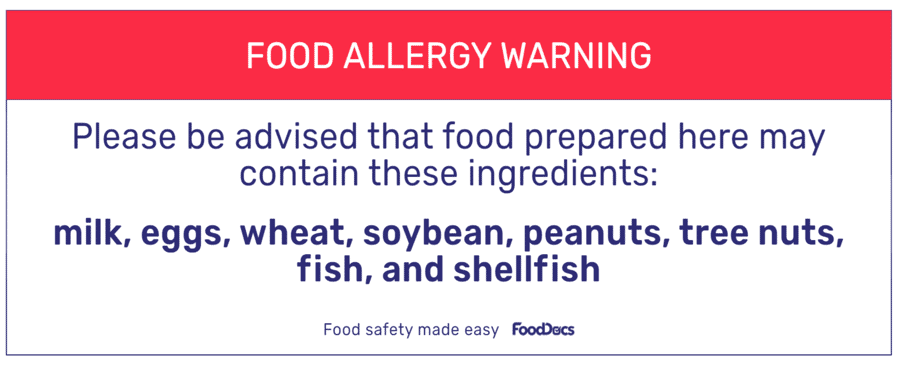
Food allergy warning examples
Depending on the situation, you can use different forms of food allergy advisory warnings. Some of them are meant for the customers, whereas some can be for your team members. The most important thing is that the food allergy warning conveys the intended message which is to let consumers tell the food handlers whether they have food allergies or none.
Here are a few statements that you could use in a food allergy warning sign. Feel free to use them accordingly.
Top 4 examples of Food allergy statements
Not all allergy warning signs need to sound the same. Depending on your business style and legal requirements, here are examples you can adapt:
1. General disclaimer
Please be advised that food prepared here may contain or come into contact with milk, eggs, wheat, soybeans, peanuts, tree nuts, fish, shellfish, or sesame.
2. Staff notification prompt (legally required in Massachusetts)
Before placing your order, please inform your server if a person in your party has a food allergy. (Required by MA General Law Chapter 140, §6B)
3. Welcoming tone
We understand food allergies can be serious. Let us know your needs, and we’ll do our best to accommodate you safely.
4. Takeout/delivery statement
Allergens may be present in our kitchen. Please check our allergen chart online or contact us before ordering.
Where should you display allergy warning notices?
Posting a food allergy warning is most effective when it’s visible, accessible, and consistently placed.
Key locations to post signs
- Entrance door: Helps inform before the customer orders.
- Ordering counter: Reinforces awareness during the decision-making point.
- Menus (printed and digital): Place at the top or bottom of each page.
- Kitchen or staff prep area: For internal reminders and training.
- Online ordering pages or apps: Especially for takeout or delivery services.
What are some best practices for writing and displaying your allergy notice sign?
- Use plain language customers can easily understand.
- Make it actionable by encouraging customers to speak up.
- Include the specific allergens most relevant to your menu.
- Place the message in multiple locations: menus, checkout, entrance, or digital order screens.
- Use simple, bold fonts with high contrast.
- Keep signs at eye level and in well-lit areas.
- Avoid cluttered or crowded walls (the message should be obvious and standalone).
- Check signs regularly and replace any that are faded, outdated, or damaged.
You can use our free food allergy warning template above and customize it with the information that you want to share with your customers. Download and print your food allergy warning template and place it in visible areas of your food company as precautionary labels. Remind your employees of how important these warnings are for the sake of your consumers with food allergies.
To summarize and help you understand more about food allergy warnings, here are a few frequently asked questions:
How do you write a food allergy warning?
Crafting an effective allergy warning is all about clarity, visibility, and legal awareness.
Here are tips to write a strong allergy warning for your business:
1. Be specific when possible
List the exact allergens your business handles frequently (e.g., "This kitchen uses peanuts, milk, eggs..."). If there’s a risk of cross-contact, add that too.
2. Use clear and simple language
Avoid overly formal or vague statements. Use direct phrasing like: “This food contains allergens” or “May contain traces of...”
3. Include a customer prompt
Encourage customers to speak up. Phrases like “Please let us know if you have any food allergies” reduce guesswork and promote dialogue.
4. Format for visibility
Use bold text, high-contrast colors, and large font sizes. Place notices near ordering points, entrances, and digital screens.
5. Consider language and accessibility
If you operate in a multilingual region, consider printing warnings in multiple languages. Universal icons can help but don’t replace text.
6. Update as needed
Menus and signage should reflect any changes to ingredients or recipes. Keep allergen lists current — especially if you use seasonal or rotating menus.
For extra guidance, review the FDA Food Code allergen disclosure guidance and your local health department’s signage regulations.
Are there warning signs before a food allergy?
Before adverse reactions kick in, the most common food allergy symptoms manifest as itching or tingling in the mouth, hives, or some swelling. If left untreated, these symptoms can worsen.
What are the 14 legal allergens?
In the UK and EU, food businesses must inform customers if any of the following 14 allergens are present in their food, as required by the Food Information for Consumers Regulation (EU) No 1169/2011:
| Allergen | Examples |
|---|---|
| Celery | Celery sticks, spice blends, soups |
| Cereals containing gluten | Wheat, barley, rye, oats |
| Crustaceans | Shrimp, crab, lobster |
| Eggs | Mayonnaise, baked goods, pasta |
| Fish | Sauces, dressings, stock |
| Lupin | Lupin flour, certain baked goods |
| Milk | Butter, cheese, yogurt |
| Molluscs | Mussels, clams, squid |
| Mustard | Salad dressing, sauces |
| Nuts (tree nuts) | Almonds, hazelnuts, walnuts |
| Peanuts | Peanut butter, sauces |
| Sesame seeds | Buns, hummus, tahini |
| Soybeans | Soy sauce, tofu, processed foods |
| Sulphur dioxide and sulphites | Dried fruits, wine, pickles |
Why allergy warnings belong in your Food Safety Management System
Allergy warning signs are just one part of a complete allergen control strategy. To ensure safety and compliance, your business needs an organized approach. That’s where a Food Safety Management System (FSMS) comes in. A strong FSMS should include:
- Up-to-date allergen charts for every menu item
- Documented staff training on allergy awareness and emergency response
- Cross-contact prevention protocols (e.g., separate prep areas, utensils)
- Incident response plan for managing allergic reactions
- Accurate customer communication across menus, signage, and service
Your team must be able to efficiently monitor improper food handling practices which can cause problems including cross-contamination of major food allergens.
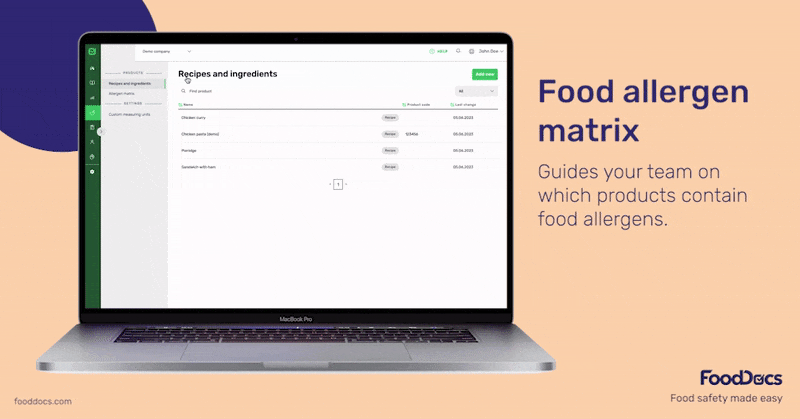
A comprehensive FSMS can help prevent problems from food allergens and ensure compliance with food safety regulations. At FoodDocs, giving every food business access to an efficient, easy, and comprehensive FSMS is what we aim for. To top that off, we provide a way for food businesses to gain a digital Food Safety Management System fit for specific operations.
Our system software is powered by artificial intelligence and intuitively helps food business owners get a complete digital FSMS in just an average of 15 minutes. The process starts with answering a few basic questions about your operations and the nature of your food business. After this, our system cross-references your answers with similar-natured food businesses and automatically generates a digital FSMS for you.
Here are a few core benefits that you can get from our digital FSMS
- Automatically set up digital monitoring forms that can help your team save time. These forms can be set to be automatically filled with information based on previously entered data.
- Get a real-time dashboard that can help you review your food safety operations. Identify which areas need attention and which ones are doing well.
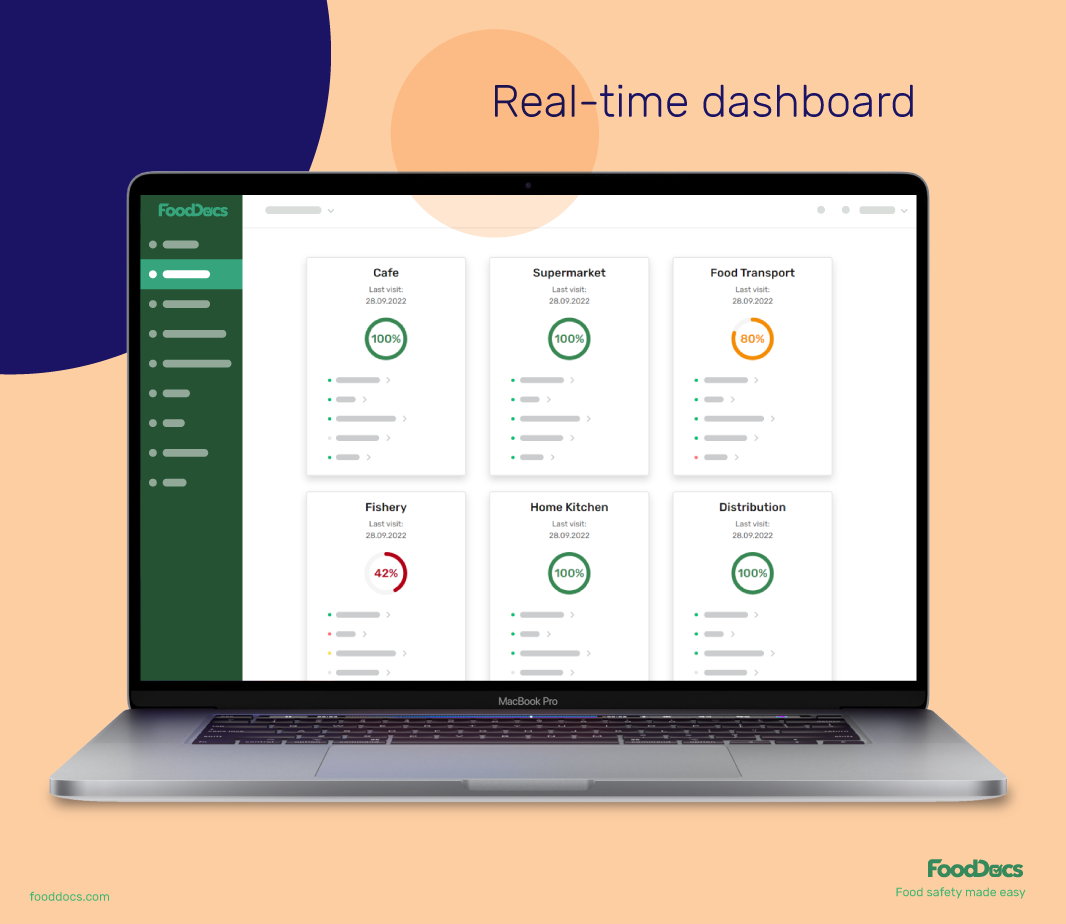
- Receive smart notifications from our mobile app that reminds your employees about daily tasks.
-
Get access to cloud storage where you can store all of your documents in a single space. Organize and access everything efficiently.
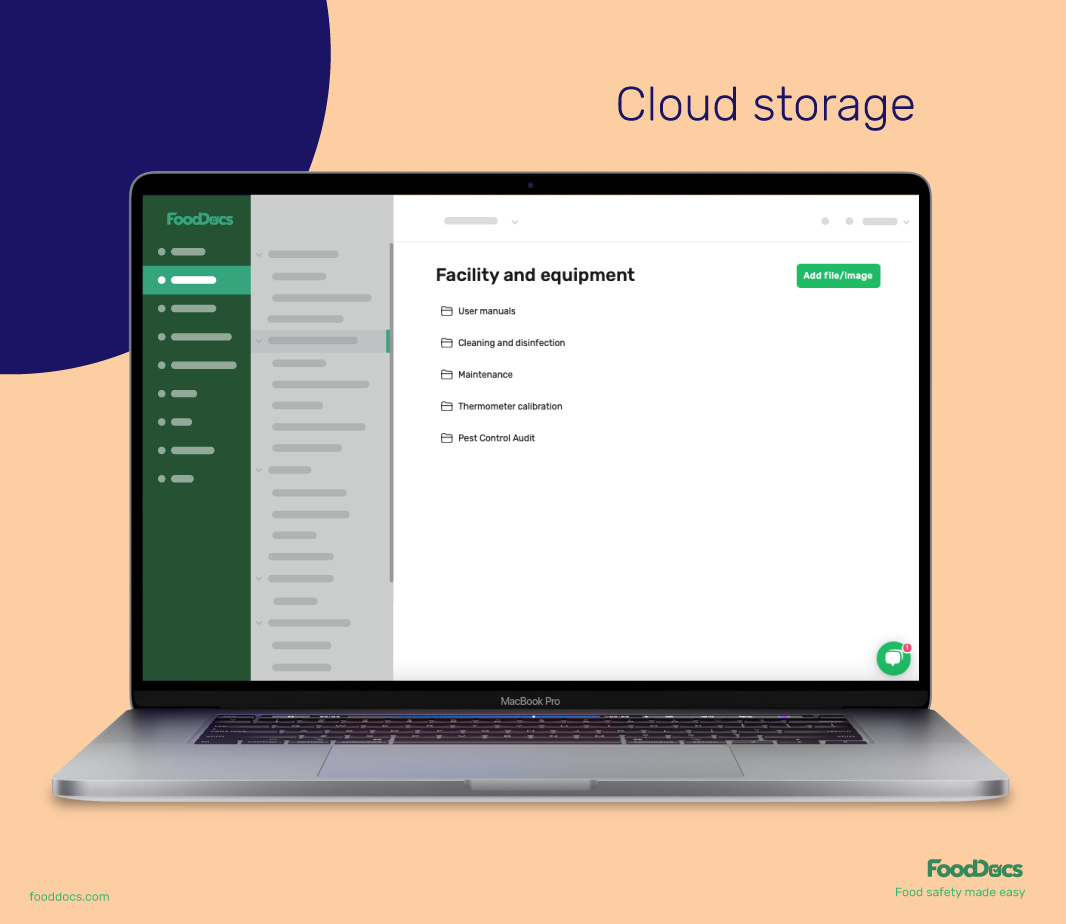

With our digital FSMS, you can save at least 20% of your time from supervising your food safety tasks. Use this time to manage other business operations and help your food establishment gain more.
Our system was conceptualized and made by food safety experts who have been in the food business for years. Rest assured, our team at FoodDocs understands your needs and how important a comprehensive FSMS is. With our digital FSMS program, we can help you remain compliant with local and international food safety laws and protect your consumers from any foodborne disease.
Join more than 10,000 satisfied customers that are enjoying our services at FoodDocs. Achieve compliance and remain compliant with food safety rules by trying our free, 14-day trial.
